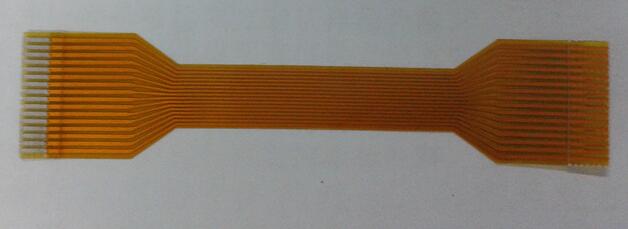FPC circuit boards are a type of PCB with a cylindrical or rectangular shape that can be changed in size according to the requirements of their application.The standard divides FPC circuit board into two categories: rigid and flexible. Rigid FPC helps to mechanically connect parts, but cannot be bent.Flexible FPC is a double-sided PCB that can withstand bending forces. In addition, we mainly use it for power interconnection applications. FPC is easy to modify and customize without any soldering.
The flexibility of FPC allows for different solutions. It significantly reduces the cost of printing new boards for specific applications. We use FPC in applications where flexibility and conductivity are required. However, we will not use it when we need mechanical strength. Because FPC is thin and light, we use it in portable devices such as mobile phones, digital cameras and walkie-talkies. We can use them in large devices such as peripherals and power supplies.

FPC circuit board
Trace Width Advantages
One of the huge advantages of FPC technology is maintaining high trace width, which improves performance. This performance improvement is significant for wireless applications. There is a significant difference between the time it takes for a wireless signal to propagate from one point to another on a circuit board and the time it takes for the signal to be interfered with by noise and interference. Higher trace width can achieve greater signal integrity by reducing these delays while increasing data rate and transmission range.
Another advantage of FPC technology is its low dielectric constant (low εr). Compared to other materials (such as FR-4), PET allows for smaller trace widths and higher performance. Using low εr in FPC traces can also reduce trace width variation, which improves signal integrity.
Power Characteristics
FPC offers several power advantages, primarily due to the use of PET. As mentioned earlier, PET is a low-dielectric material, therefore FPCs utilizing PET can achieve lower trace width variation. Reduced trace width variation improves noise immunity and signal integrity. Additionally, FPCs allow for easy routing, leading to higher manufacturing yield. Low-temperature co-fired ceramics (LTCC) and silicone also contribute to the FPC process. They provide enhanced thermal performance for the circuits. The most common FPC fabrication method is transfer printing. This is because it involves transferring ink to a surface using pressure. Part of the surface is then etched away to create the circuitry. Transfer printing allows for very high throughput, which is necessary for the circuits we might need for wireless communication.
Manufacturing Technology
FPC manufacturing is a complex process involving many different materials and processes. We can manufacture FPCs by transferring ink onto a flexible substrate. This creates the circuitry and removes part of the substrate to expose the circuit. We then use high-resolution printers applying 500-800g/cm² of pressure to transfer the ink. The ink used in FPC manufacturing includes a mixture of photoinitiators and photoresists. This allows for high-speed propagation. We can first print the desired areas of the circuit. Then, we deposit a thin film on top of the printed area to act as an etching mask. The exposed region is then etched away using oxygen plasma etching to produce the desired circuit. The final step in the FPC manufacturing process is cutting the circuit into the appropriate shape. The circuit must be thin enough to accommodate any movement, and thick enough to maintain durability and functionality. FPC thickness typically ranges from 0.031mm to 0.065mm. However, for special applications (e.g., wearables), it can be as thin as 0.01mm or even less.
Applications of Flexible PCB
FPCs have various applications in multiple different fields.We use FPCs in solar panels, mobile phones, vehicles, and airplanes.Many of these applications require thin and durable flexible sheets. Therefore, they can withstand bending, folding, or rolling.
FPCs are becoming indispensable in printed circuit boards.They also work best in circuits printed on flexible substrates,typically made of PET or laminated silica dioxide.FPCs are an ideal choice for PCBs because they can withstand high temperatures. They can also easily integrate into PCB circuit boards and offer excellent flexibility. FPC is a versatile component used in a wide range of applications.Due to the versatility of FPCs,we can utilize them in various applications requiring high durability and low-cost embedded components. This flexibility and capability make FPC circuit board ideal components for many projects, including solar panels and mobile phones.